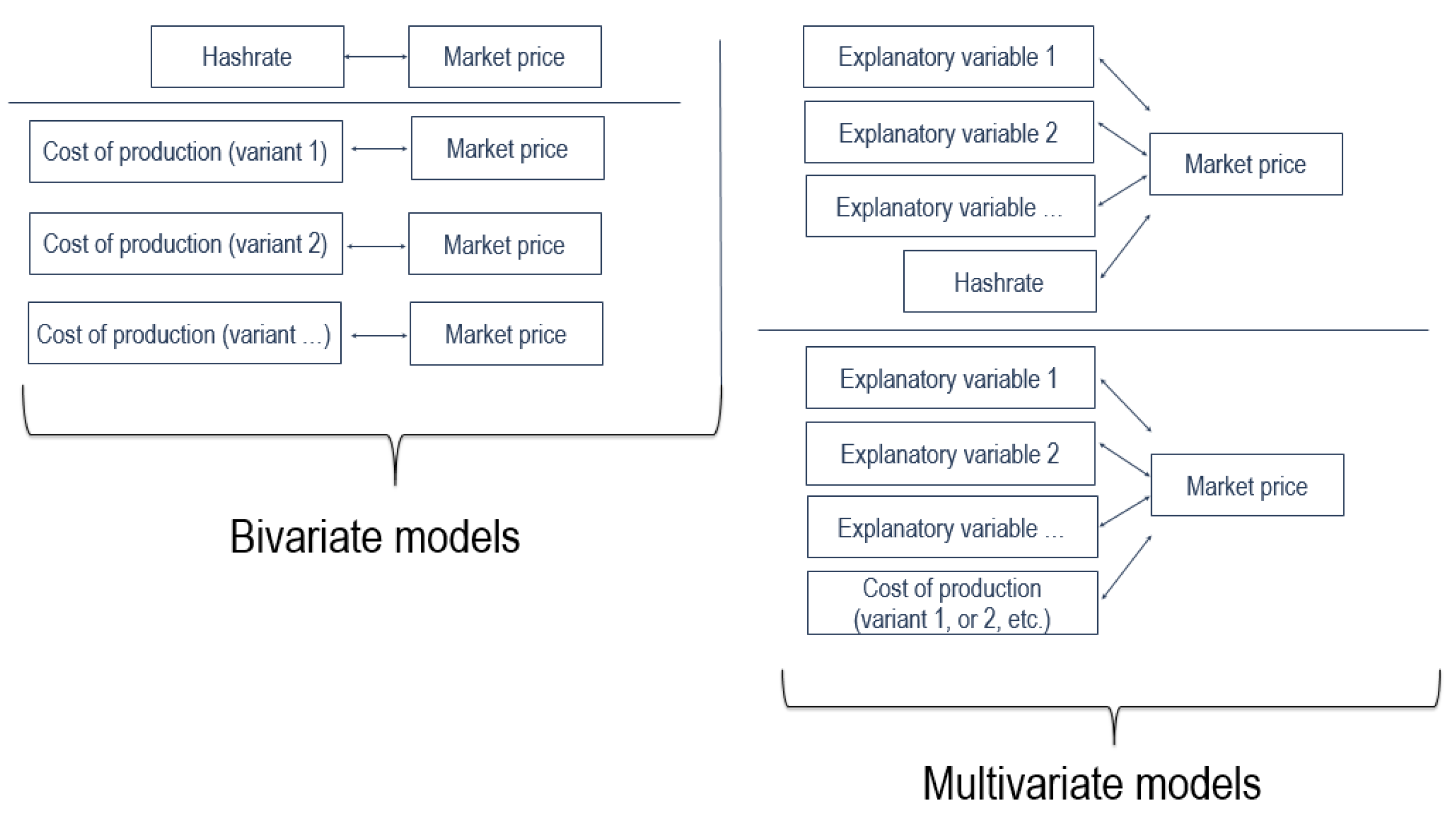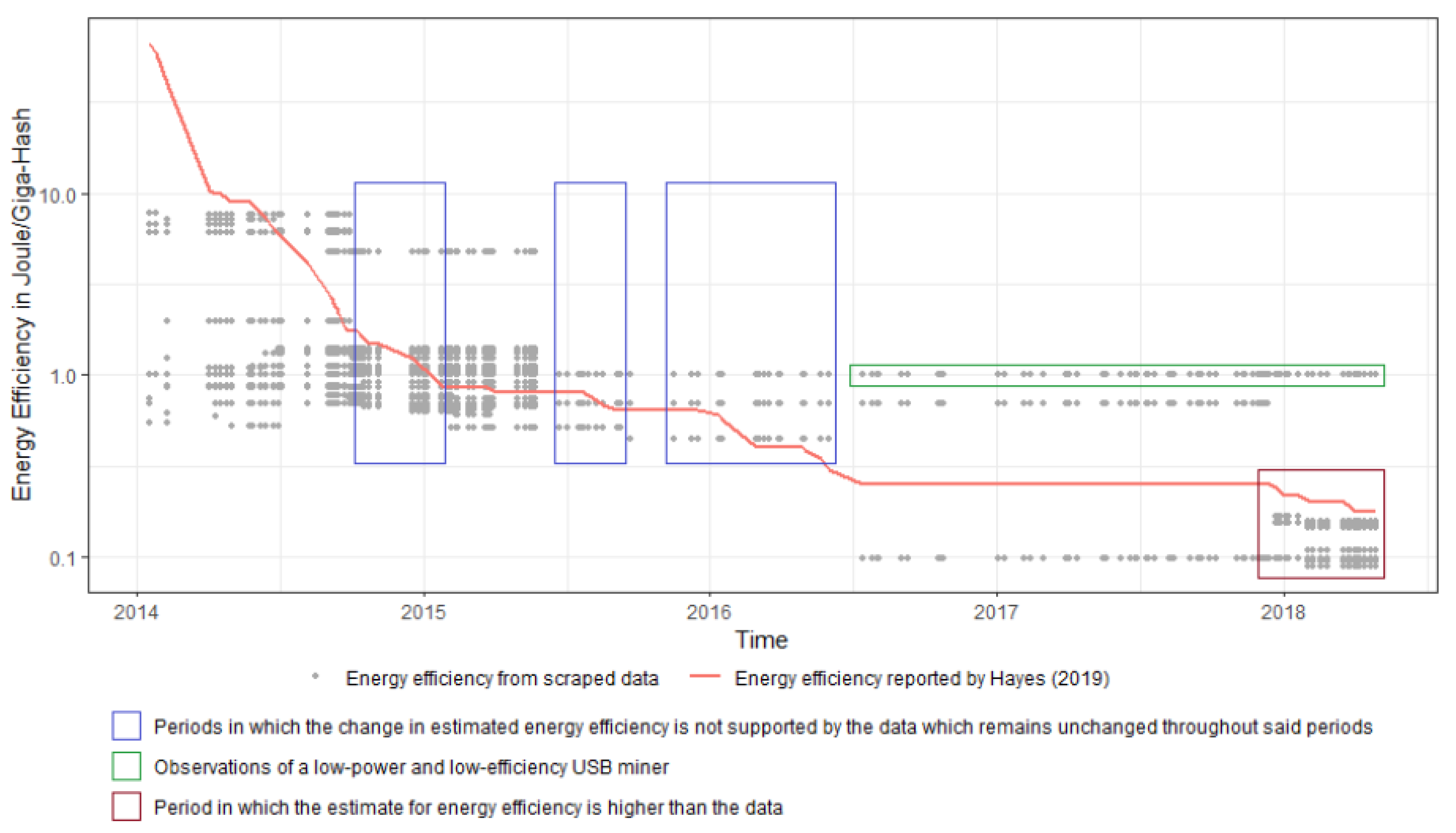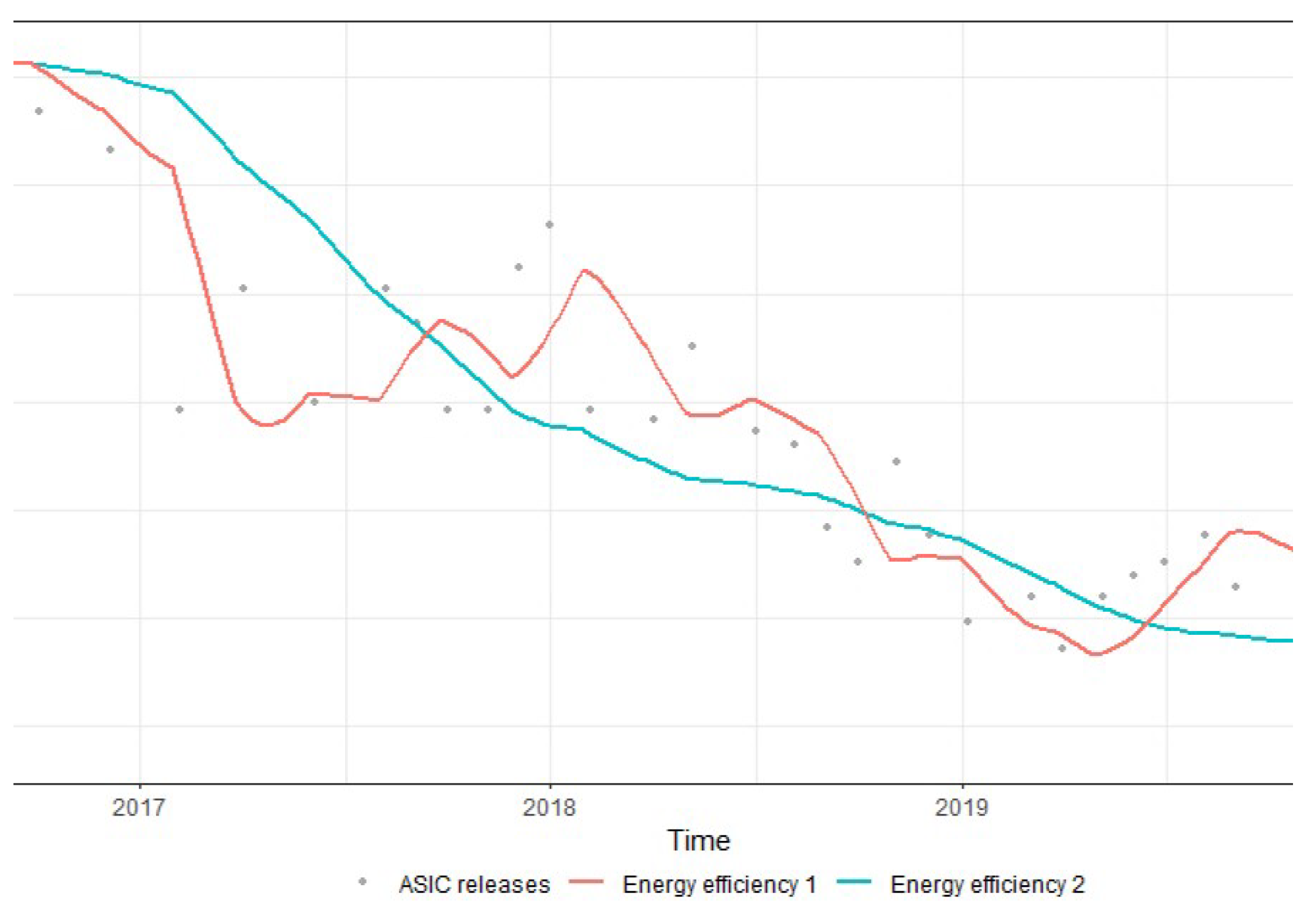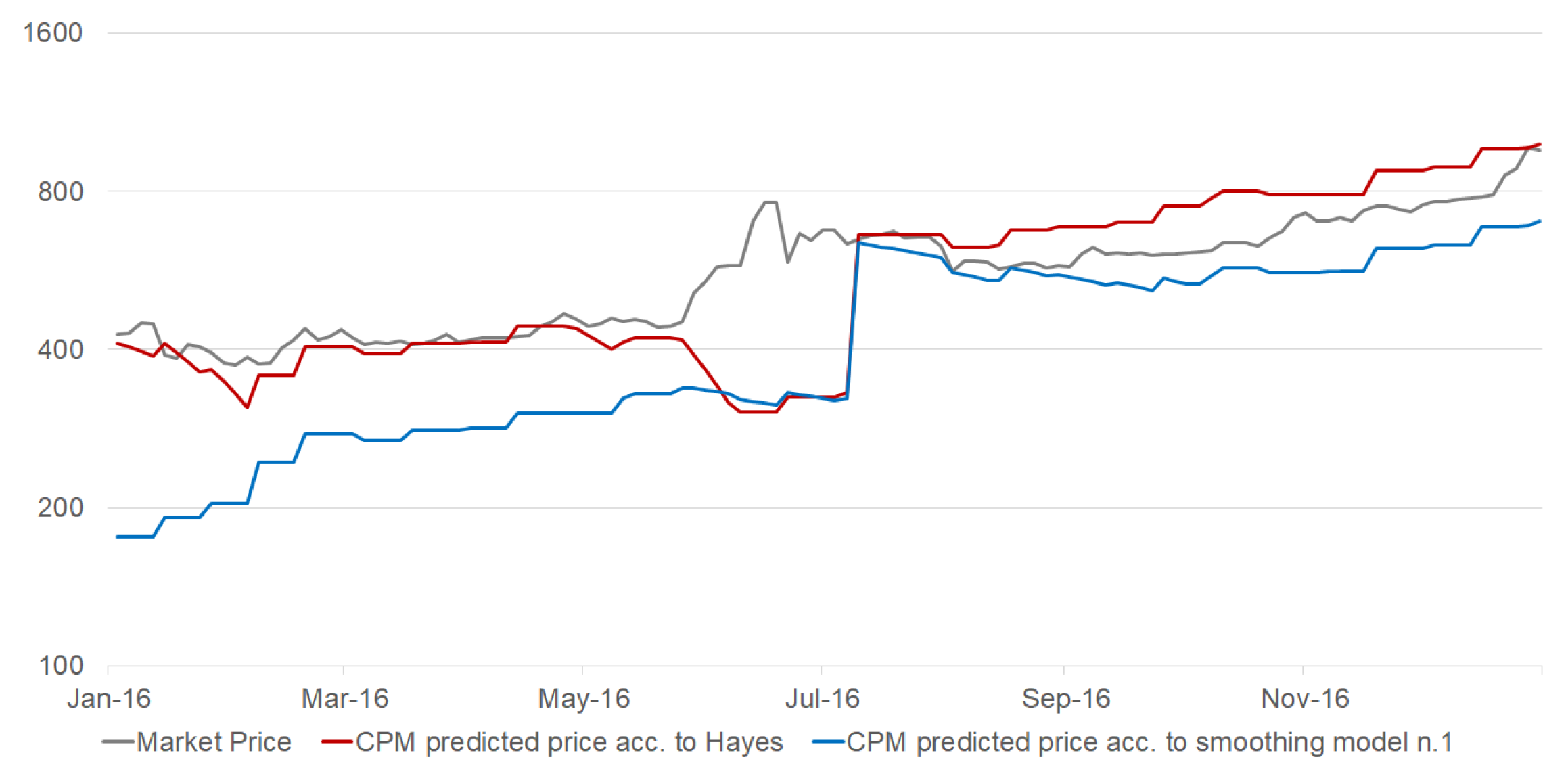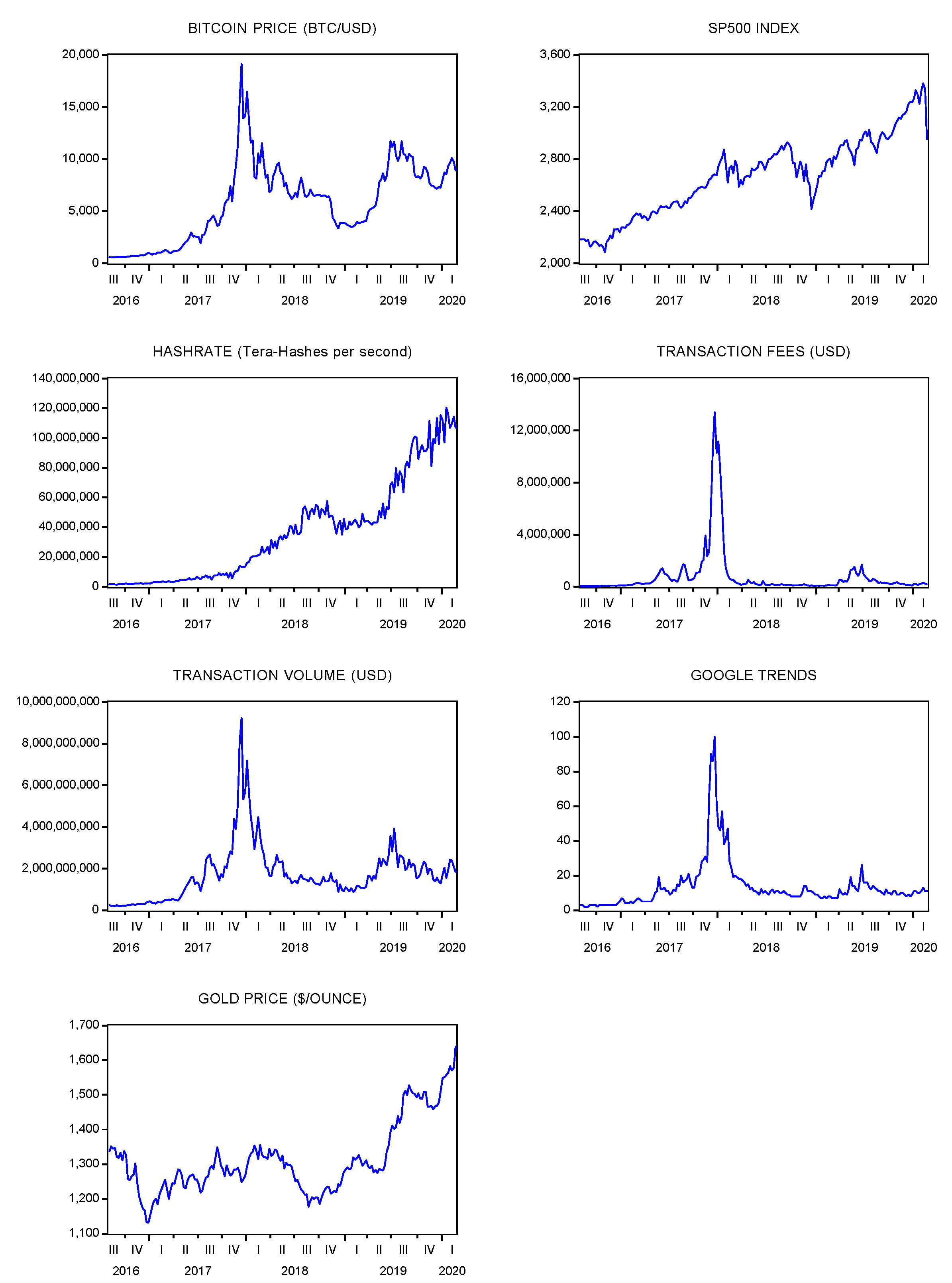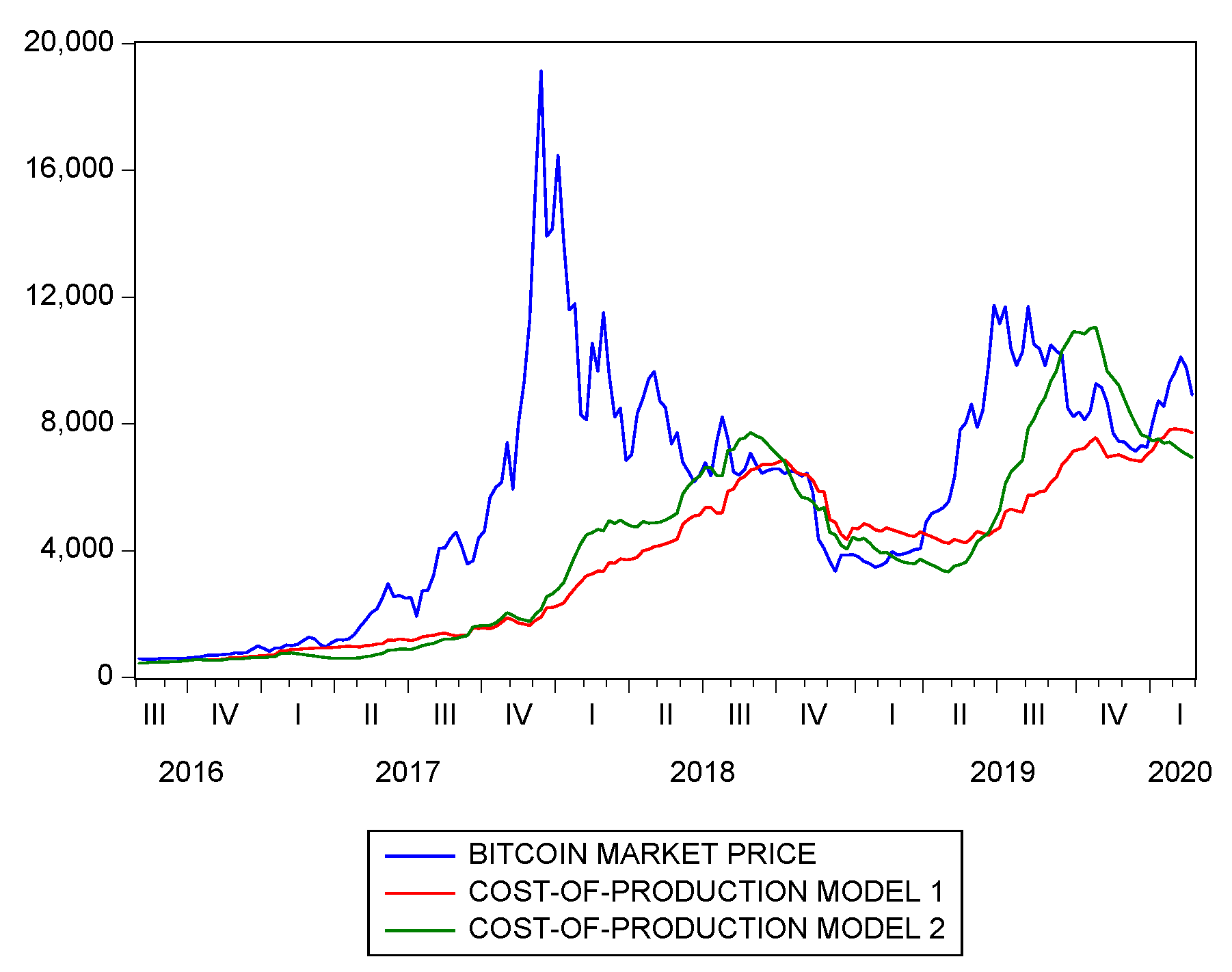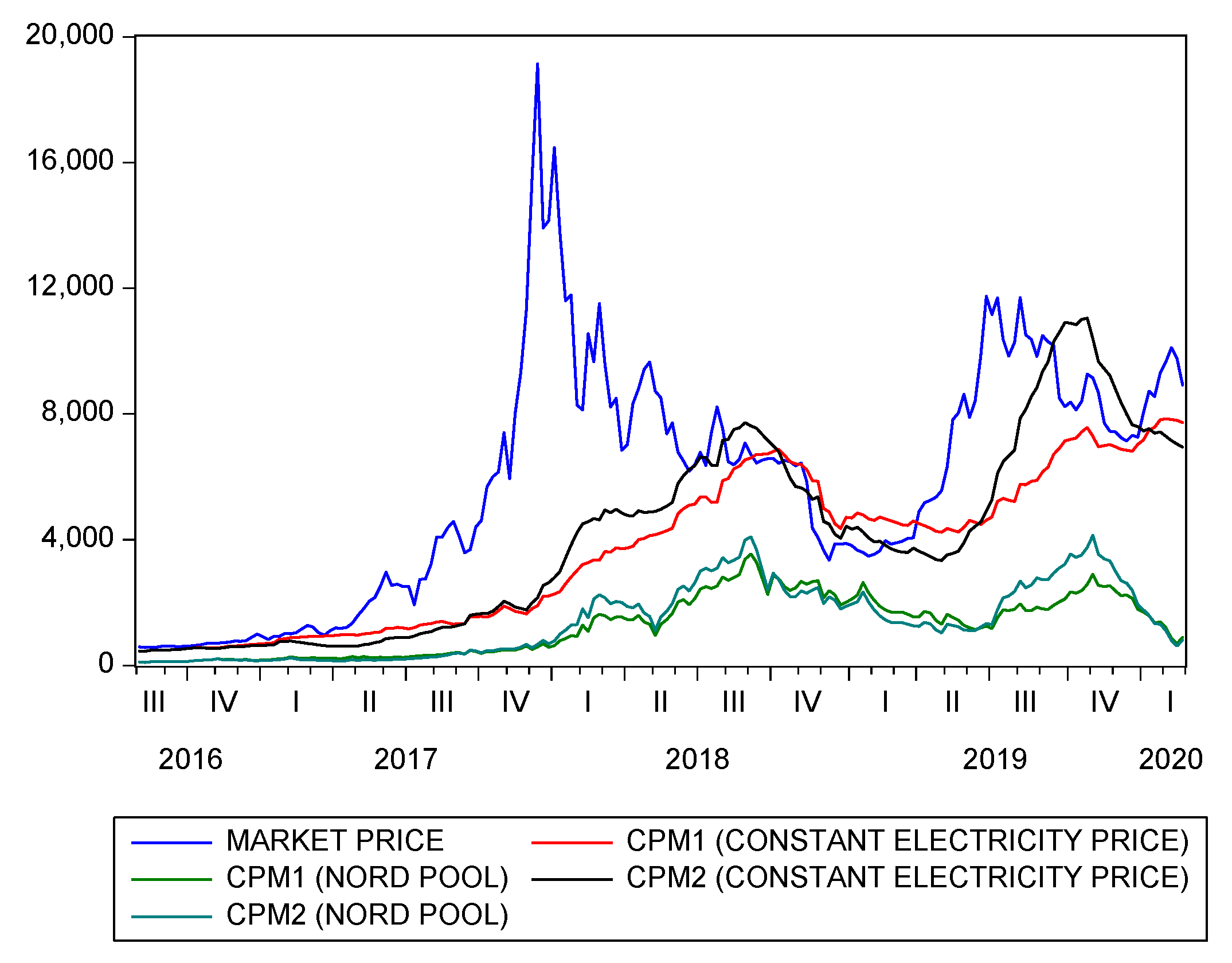1. Introduction
There is a growing interest in bitcoin price dynamics both among the general public and in academia, see
Burniske and Tatar (
2018);
Brummer (
2019);
Fantazzini (
2019);
Schar and Berentsen (
2020). The price is not only important for purely speculative reasons but also for its role in the energy consumption of the Bitcoin network, and in affecting the future behavior of miners—agents who power the Bitcoin infrastructure by issuing new blocks containing the latest transactions.
There is a long-lived perception that the bitcoin price and the hashrate (i.e., the number of computations done by bitcoin miners) are connected, see for example
Cointelegraph (
2020). Some works in the financial literature went further and theorized that the movements of the hashrate are useful in predicting the bitcoin price (
Hayes 2017,
2019;
Aoyagi and Hattori 2019). At first glance, such a notion might seem wrong because producers are price-takers in competitive markets, and the amount of effort they put into the production of a good or service have no impact over the market price. However, this might not be the case for the bitcoin market. First, there are only a few mining pool operators, so that they can coordinate their actions in an attempt to control the market price. Second, the fact that bitcoin supply is inelastic and the mining business is very competitive might force miners to operate differently: they might be willing to cap their income by hedging their losses with the bitcoin futures introduced by the Chicago Mercantile Exchange and the CBOE in December 2017 (
Chicago Mercantile Exchange 2017) as discussed in the cryptocurrency professional literature (see, for example, the several articles published on
coindesk.com and
cointelegraph.com)
1. The exact economical behavior of miners is unknown and its modeling is beyond the scope of this paper. However, if we focus only on the influence of the hashrate on the bitcoin price dynamics, we can resort either to econometric models or to a general equilibrium model that omits the inner workings of miners’ decision-making but directly models the relationship between the hashrate and the price. Such an approach was first proposed by
Hayes (
2017), who put forward a methodology able to predict the bitcoin price using the total hashrate and the miners’ energy efficiency as inputs.
Hayes (
2019) showed that this model provided a surprisingly good fit and its equilibrium price was able to Granger-cause the bitcoin price. On the other hand, several works explained the dynamics of the bitcoin price using econometric models and various sets of explanatory variables, and they mostly found that the hashrate is not statistically significant and it does not help in predicting the bitcoin price, see
Kjærland et al. (
2018) and references therein.
These conflicting results drew our attention and became the main motivation for this work: we initially thought that this contradictory evidence could have been due to different sample periods (hence different price drivers at different times), but this is not the case: they largely intersect. A possible explanation could be that the hashrate is not useful in predicting the bitcoin price on its own, but it has a more complex relationship with it, as discussed by
Hayes (
2017).
In this paper, we examine the relationship between the hashrate (or the bitcoin cost-of-production price) and the market price, and we try to reconcile the previous contradictory findings by disentangling the effects of the energy efficiency of the bitcoin mining equipment, bitcoin halving, and of structural breaks on the price dynamics.
The first contribution of the paper is a methodology based on exponential smoothing to model the dynamics of the Bitcoin network energy efficiency as a whole. This type of smoothing naturally trails the data and it does not use future values: the data related to future mining equipment cannot be used to infer today’s performance to avoid any form of look-ahead bias. Moreover, this approach easily models the gradual replacement of old equipment with the new units.
The second contribution of the paper is a set of multivariate models to investigate the nature of the relationship between the bitcoin market price and the hashrate, both directly or through the proxy of production costs.
The third contribution of the paper is a robustness check to verify how our results change when computing the bitcoin cost-of-production using an electricity price no more fixed to a constant but equal to the daily data of the Nord pool system price, which is the unconstrained market-clearing reference price for the European Nordic region.
The paper is organized as follows:
Section 2 briefly reviews the literature devoted to bitcoin and the cost-of-production model, while the methods proposed to investigate the relationship between the bitcoin market price and the hashrate are discussed in
Section 3. The empirical results are reported in
Section 4, while a robustness check is discussed in
Section 5.
Section 6 briefly concludes. A brief overview of Bitcoin’s operation is reported in the
Appendix A.
2. Literature Review
One of the main approaches to model the bitcoin price behavior was introduced by
Hayes (
2017), and it is usually known as the “cost-of-production model” (CPM). The core of this approach is the attempt to derive the bitcoin cost of production for a given miner from the current state of the network, the energy prices, and the energy efficiency of the miner’s equipment. The CPM thus gives the break-even cost of mining, which any individual miner would use when trying to define whether he should be involved in mining bitcoin.
Hayes (
2017) generalized this approach for the whole network.
Hayes (
2017) makes a few assumptions to estimate the main drivers of the bitcoin price. The first one is that the more computational power is employed by the Bitcoin network, the higher its value is. The second assumption simply states that all miners are rational, meaning that they are only willing to mine for bitcoin if they are looking to extract profit. This also implicitly means that any other cryptocurrency with no demand for it would have zero value and zero mining effort employed, and a rational miner would redirect its resources elsewhere. The third and final assumption is that the network difficulty can be used as a proxy of the aggregate mining power. Within the Bitcoin network, this assumption is directly supported by the algorithm governing it: difficulty always readjusts to ease off the effect of increased mining power or, in the opposite case, to make up for its decrease.
Hayes (
2017) builds a framework aimed at showing the connection between the computational power employed by a miner and its expected profit given the current network conditions. When a single miner estimates its baseline profitability, it first calculates the expected number of bitcoins produced per day:
where
is block reward (bitcoin per block),
is the difficulty (expressed in units of Giga-Hash/block),
is the hashing power employed by a miner expressed in Giga-Hash/second,
is the number of seconds in an hour,
is a number of hours in a day and
is a normalized probability of a single hash “solving” a block and is an attribute of the mining algorithm. These three constants can be fit into a single parameter
, so the formula takes the following view:
The daily cost of mining can be expressed as follows,
where
is the cost per day for a producer,
is the price of a kilowatt-hour, and
is the energy consumption efficiency of the miner’s hardware. Given the assumption of perfect competition so that the marginal cost of production and the marginal profit are equal, the equilibrium price takes the following form:
where we set
GH/s as in
Hayes (
2017). The CPM offers a simple but effective framework for estimating the cost of production price. However, it simplifies the mining expenses by dismissing several other important factors, such as the capital and the operational expenses of the running mining operation. Another important drawback of this model emerges around the times of the bitcoin halving events, when the reward in bitcoins for finding new blocks is cut in half: unlike real-world miners, this model does not anticipate this change and therefore it produces unreliable results (this issue will be discussed later in this paper). Interestingly,
Hayes (
2019) found that the CPM Granger-causes the market price but not the other way around.
It is important to remark that the CPM proposed by
Hayes (
2017,
2019) requires a few inputs which cannot be directly observed or reliably approximated: one such input is the
electricity cost, which is assumed by Hayes to be a constant equal to USD 0.135 per kWh—an average rate for electricity worldwide at the time of publishing those two papers. Of course, this is not always the case for miners: there are multiple reports of some miners having free energy (either as a form of subsidy or just by using it covertly), which are cited and discussed in
Stoll et al. (
2019). Another input is the parameter for the
equipment’s energy efficiency: while it is possible to determine the best mining equipment available at a certain point in time, it is impossible to know the distribution of this equipment among miners and thus the average energy efficiency of the network. Moreover, there are ASIC models whose presence on the market is very limited, but the impact may be high, like—for example—the GMO miners (
gmominer.z.com/en). Therefore, this situation makes it very difficult to assess the real picture of the total energy efficiency. The CPM relies heavily on the above-mentioned data (particularly the energy efficiency), so one has to be very careful when fixing these two parameters.
Kristoufek (
2015) was among the first to highlight that the drivers behind the bitcoin price tend to vary over time due to the “
dynamic nature of bitcoin and its rapid price fluctuations”. This idea was later developed and expanded by
Kjærland et al. (
2018), who used several major commodities and indices, different metrics from the Bitcoin network, and the Google Trends data as explanatory variables to find which factors affect the bitcoin price dynamics.
Kjærland et al. (
2018) transformed the original daily data into weekly averages to avoid potential issues related to autocorrelation. Moreover, they also deal with outliers in the data and structural breaks. The data sample was then divided into three smaller periods, and Autoregressive Distributed Lag (ARDL) and Generalized Autoregressive Conditional Heteroscedasticity (GARCH) were estimated. Contrary to the findings reported by
Hayes (
2017,
2019),
Kjærland et al. (
2018) found that the hashrate of the bitcoin network does not impact the bitcoin market price, and the only period when it seemed to do so was during the bitcoin exponential growth in 2017. They concluded that, if anything, it is more likely that the bitcoin price impacts the hashrate than vice-versa. Interestingly, they also found that the efficient market hypothesis appears not to hold, as the current bitcoin price can be explained by its own lags: they assume that investors are probably affected by the momentum effect of rising prices and vice versa where, as the price rapidly rises, “
investors see get-rich-quick potential by buying now and selling to a greater fool next week”, see
Santoni (
1987) for a review of the “Greater Fool theory” and
Jegadeesh and Titman (
1993,
2001) for a detailed discussion of the “Momentum theory”. Furthermore, they also showed that Google Trends data has a positive and significant impact on bitcoin price (similar to previous studies), and the S&P500 has a positive impact on bitcoin price as well, interpreting this index as an indicator of investors’ overall optimism and willingness to invest in any assets. Gold and oil are found to be insignificant, as well as the VIX index
2 (except for one period).
3. Materials and Methods
The main goal of this paper is to investigate the nature of the relationship between the bitcoin market price and the hashrate, either directly or through the proxy of production costs. Since we do not know the true nature of this relationship, we try to model it with a large set of econometric models.
First, we look for any direct relationship between the market price and the hashrate, or between the market price and the cost of production price. This process follows these steps:
We test each variable for unit roots allowing for a structural break.
If the null of a unit root is rejected and a significant break is found, the sample is divided into two subperiods, and we test for cointegration between the market price and the cost-of-production price, or between the market price and the hashrate, in all sub-samples. Depending on the test result, either a bivariate cointegrated model or a bivariate vector-autoregression (VAR) model with variables in the first differences is estimated.
We test for Granger causality using the approach by
Toda and Yamamoto (
1995), which is consistent even if the processes may be integrated or cointegrated of arbitrary order. More specifically, this approach requires the determination of the optimal VAR lag length
k for the variables in levels using information criteria, and then to estimate a (
)th-order VAR where
is the maximum order of integration for our group of time-series.
Toda and Yamamoto (
1995) show that we can test linear or nonlinear restrictions on the first
k coefficient matrices using standard asymptotic theory, while the coefficient matrices of the last
lagged vectors must be ignored. This Granger-causality test is performed in all subsamples.
Even though this bivariate analysis can be a useful starting point, a full multivariate analysis is needed to analyze the bitcoin price dynamics and to avoid any potential omitted-variable bias. We considered the set of variables used by
Kjærland et al. (
2018) because these explanatory variables represent a good summary of what the literature has found so far in terms of factors affecting the bitcoin price. This set was augmented with the cost-of-production price, which served as an alternative to the hashrate.
To select the best multivariate model, we followed the structural relationship identification methodology discussed by
Sa-ngasoongsong et al. (
2012) and
Fantazzini and Toktamysova (
2015). In a nutshell, the first step is to identify the order of integration using unit root tests and, if
all variables are stationary, VAR or VARX (Vector Autoregressive with exogenous variables) models are used. The second step determines the exogeneity of each variable using the sequential reduction method for weak exogeneity by
Greenslade et al. (
2002), who consider weakly exogenous each variable for which the test is not rejected and re-test the remaining variables until all weakly exogenous variables are identified. For
non-stationary variables, cointegration rank tests are employed to determine the presence of a long-run relationship among the endogenous variables: if this is the case, VECM or VECMX (Vector Error Correction model with exogenous variables) models are used, otherwise, VAR or VARX models with variables in differences are applied, see
Sa-ngasoongsong et al. (
2012) and
Fantazzini and Toktamysova (
2015) for more details. However, our approach differs from the latter in that we employ unit root tests allowing for a structural break: if a significant break is found, the sample is divided into two subsamples and the next steps are computed with these samples separately, similarly to the analysis performed by
Kjærland et al. (
2018) with bitcoin prices.
We remark that the cost-of-production price is strongly affected by three parameters: the energy efficiency of the Bitcoin network, the electricity price, and the bitcoin reward when a new block is created. Setting the first two parameters is not straightforward and several variants can be used, while the third parameter can cause undesired effects at the time of the bitcoin halving events when the bitcoin reward is cut in half. We discuss these issues in the next sections, while a summary of our modeling strategy is presented in
Figure 1.
3.1. An Exponential Smoothing Approach to Model the Dynamics of the Bitcoin Network Energy Efficiency
One of the most important parameters of the CPM described by Equations (
1)–(
3) is the energy efficiency of the mining equipment for the whole Bitcoin network. Finding a reliable estimate for this parameter is a very challenging task due to the scarcity of data for most mining pools, if not the complete lack of data.
Hayes (
2019) computed this parameter by extracting energy efficiency data from Bitcoin mining hardware manufacturer websites and by checking them against a dedicated wiki page that catalogs the efficiency of the mining hardware (
https://en.bitcoin.it/wiki/Mining_hardware_comparison). He then …“
collected these data for each date of difficulty change in the Bitcoin network, scraped from the web using the internet archive’s wayback machine”. The network energy efficiency was finally computed using a power log-function applied to these data
3. We tried to replicate and extend the Hayes’ estimated energy efficiency by web scraping data from the previous “Mining hardware comparison” webpage. However, when we overlaid the energy efficiency estimated by
Hayes (
2019) with the scraped ASIC data, we found some anomalies, see
Figure 2: at the end of 2015 and until the beginning of 2016, the estimated energy efficiency suddenly changes but the ASIC release data do not. Moreover, during the first months of 2018, several new releases were introduced but the estimated energy efficiency always stays above these releases. Furthermore, there is a line of violet dots constant at 1 Joule/GH which corresponds to USB miners, which are no longer competitive products but they still seem to be included in the computation of the energy efficiency even in 2017–2018.
Given these issues, we decided to follow a different approach. First, we examined a couple of websites that catalog the bitcoin mining equipment (see
ASIC Miner Value 2020 and
Crypto Mining Tools 2020), and we scraped their data and cross-checked it with vendor websites and online marketplaces to find any possible discrepancies. Then, following the idea proposed by
Stoll et al. (
2019) to compute lower and upper bands for the energy efficiency, we decided to use two alternative
Holt-Winters double exponential smoothing with the scraped data to model the dynamics of the energy efficiency for the whole Bitcoin network. We chose this kind of methodology for the following reasons:
This type of smoothing naturally trails the data and it can model the gradual replacement of old equipment with the new one. Changing the coefficients of the smoothing function impacts the length of such lag.
It accounts for a trend that is present in the data.
The energy efficiency of future ASICs cannot be used to infer today’s performance, so any smoothing function referring to future values cannot be used.
The Holt-Winters double exponential smoothing function and its parameters for two alternative models are reported below:
where
is the raw data sequence of ASICs energy efficiencies (measured in Joule/Giga-Hash),
is the smoothed value at time
t and it represents an estimate of the energy efficiency for the whole Bitcoin network, while
is the estimate of the trend at time
t. The parameters for the two alternative smoothing models were chosen to give the equipment a reasonable replacement rate of 2–3 months
4, and to get two smoothed curves: one with slow and smooth energy efficiency development over time and the other with more abrupt changes around the release dates of new hardware. Using this approach, we computed the change of the network energy efficiency over time that is reported in
Figure 3.
3.2. The Cost-of-Production Model and Electricity Prices
The electricity price was fixed to a constant (0.13 dollars per kWh), similarly to
Hayes (
2017,
2019). Even though the actual electricity price might be lower for miners—after all, they are active seekers of cheap electricity—we chose this level for two reasons: (1) there is no better-educated guess; (2) if we assume electricity prices which are potentially higher than the real ones, we can capture the effect of some other mining operational expenses, as discussed by
Stoll et al. (
2019). This assumption will be relaxed in
Section 5, where we will discuss a robustness check involving electricity prices changing every day.
3.3. The Cost-of-Production Model and the Bitcoin Reward Halving
The bitcoin halving happens once approximately every four years and cuts the block reward (and thus the future cash flows of miners) in half. The cost-of-production model does not account for this effect, but miners are aware of it and anticipate it. This is why the market price does not change significantly near the times of halving, whereas the cost-of-production model shows a sudden break in its equilibrium price. This effect is shown in
Figure 4 where a cost-of-production model is considered with two different inputs for the network energy efficiency: one as originally published by
Hayes (
2019) and another estimated using the first smoothing model in Equation (
4).
Even though the two models differ due to the different methodologies used for computing the network energy efficiency, they both show the same jump in prices at the time of the halving event in July 2016. It is for this reason that our empirical analysis considered only bitcoin market prices between August 2016 and February 2020 to exclude the two halving events which took place in July 2016 and May 2020, respectively. Accounting for these breaks and the change in miners’ behavior would have required additional assumptions and model complexities that would have probably weakened the overall analysis. This is why we leave it as an avenue for further research, and we refer the interested reader to
Pagnotta and Buraschi (
2018) and
Pagnotta (
2020) for two recent theoretical models dealing with this issue
5 6.
5. Robustness Checks
We wanted to check how our previous results changed when computing the bitcoin cost-of-production using an electricity price no more fixed to a constant but able to reflect the changing dynamics of daily electricity markets. To achieve this goal, we employed the daily data of the Nord pool
9 system price, which is the unconstrained market clearing reference price for the European Nordic region, computed without any congestion restrictions by setting capacities to infinity
10. These daily prices (originally in Euro/MWh) were transformed into
$/kWh using the daily fixing of the EURUSD pair, and they are shown in
Figure 7.
The Nord Pool is particularly interesting in our case because it reflects the increasing importance of renewable energy in the European energy mix (see
Jones 2017-chapter 5 for a discussion at the textbook level), and the “
majority of Bitcoin mining is mainly powered by what would otherwise be a wasted surplus of renewable energy” (
de Vries 2019), particularly hydro-power, see
Bendiksen et al. (
2018) for the full details.
The CPMs computed using the Nord Pool electricity prices and the two energy efficiency curves presented in
Section 3.1 as well as the CPMs computed with constant electricity prices are reported in
Figure 8, together with the bitcoin market prices.
The CPMs computed using Nord Pool electricity prices are much lower than the CPMs computed with a fixed electricity price of 0.13
$/kWh, because Nord Pool prices are significantly lower than this constant price level. As we discussed in
Section 3.2, an higher electricity price can capture the effect of some other mining operational expenses, so the CPMs computed using Nord Pool prices can be considered as proxies for the marginal cost of production, see
Fantazzini (
2019)-chapter 4 for a broad discussion of this issue.
The results using the CPMs with the Nord pool prices are not very dissimilar from the baseline case: in the first subsample, the CPM1/CPM2 were never significant, and the final model was again a bivariate VECM(1) for the Bitcoin price and Google search data, with transaction volume and transaction fees as exogenous variables. In the second subsample, there were no endogenous variables according to the sequential reduction method for weak exogeneity, and the Johansen tests similarly found no evidence of cointegration between the bitcoin market price and the CPMs. The final models turned out to be a simple bivariate random walk (VAR(0)) and a VAR(4) model for the log-returns of the bitcoin price and the CPM1/CPM2, respectively, with misspecification tests slightly worse than the baseline case.
In general, the use of the Nord Pool prices to compute the CPMs tend to soften their relationship with the bitcoin market price: this fact is already evident when looking at the correlation matrices of the log-returns for the bitcoin price, the baseline CPMs, and the CPMs computed with the Nord pool prices, which are reported in
Table A14 in
Appendix B.
6. Conclusions
This paper investigated the relationship between the bitcoin price and the hashrate by disentangling the effects of the energy efficiency of the bitcoin mining equipment, bitcoin halving, and of structural breaks on the price dynamics. To reach this aim, we proposed a new methodology based on exponential smoothing to model the dynamics of the Bitcoin network energy efficiency. We considered either directly the hashrate or the bitcoin cost-of-production model by
Hayes (
2017,
2019) as a proxy for the hashrate, to take any nonlinearity into account. We found that there was neither evidence of Granger-causality nor cointegration in the first examined sample (01/08/2016–04/12/2017), whereas there was evidence of unidirectional Granger-causality and cointegration in the second sample (11/12/2017–24/02/2020), going from the bitcoin price to the hashrate (or to the CPMs) but not vice versa. This evidence is thus consistent with a large literature in energy economics, which showed that oil and gas returns affect the purchase of the drilling rigs with a delay of up to three months, whereas the impact of changes in the rig count on oil and gas returns is limited or not significant. Moreover, our analysis showed that it is better to consider directly the hashrate rather than its proxy represented by the bitcoin cost-of-production model when modeling its relationship with the bitcoin price. These results also held after we performed a robustness check to verify how our previous results changed when computing the bitcoin cost-of-production using an electricity price no more fixed to a constant but equal to the daily data of the Nord pool system price.
The evidence reported in this work shows that the bitcoin market has become a more mature and efficient market after the introduction of regulated futures markets in December 2017. The usual technical drivers (bitcoin supply and demand), attractiveness indicators, and macroeconomic variables appear to have become either lagging indicators or no more significant in explaining the dynamics of the bitcoin price, thus confirming similar results reported by
Kapar and Olmo (
2020). In this regard, we want to remark that
Shanaev et al. (
2019) recently showed that some of the previously reported positive relationships between crypto-coins prices and their hashrate, or between crypto-coins prices and their transaction counts, were either spurious due to serial correlation or inconsistent due to endogeneity. Therefore, the development of “second-generation valuation metrics” for cryptocurrencies (
Lehner et al. 2019;
Shanaev et al. 2019) able to accommodate both modern empirical finance asset-pricing models and theory-driven valuation models is definitively a compelling avenue for further research.
